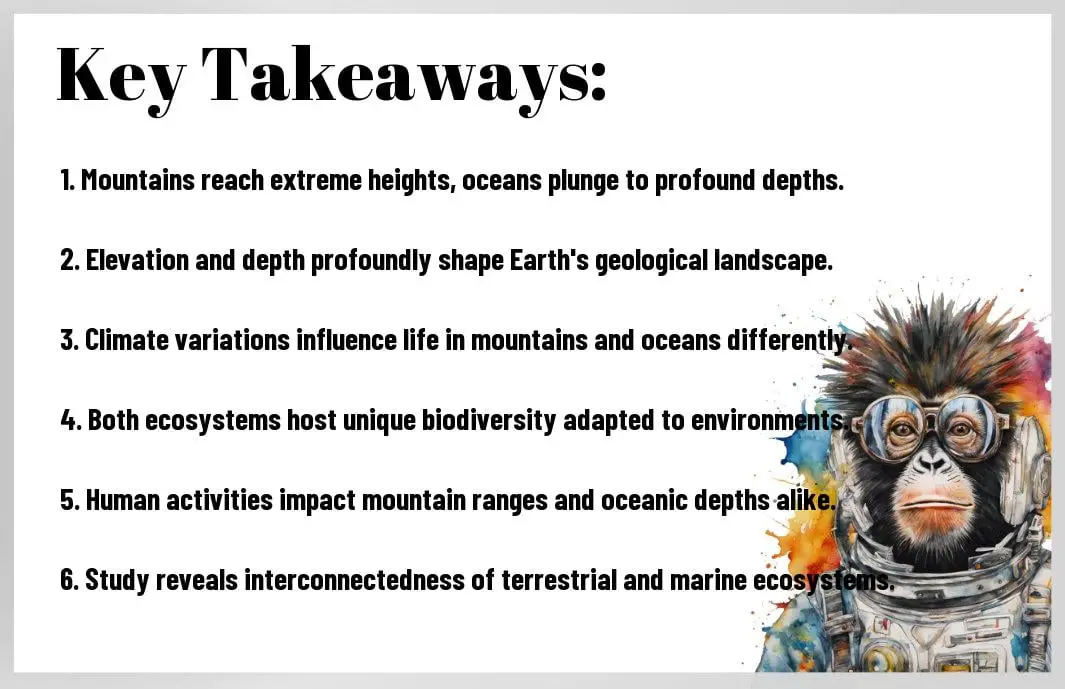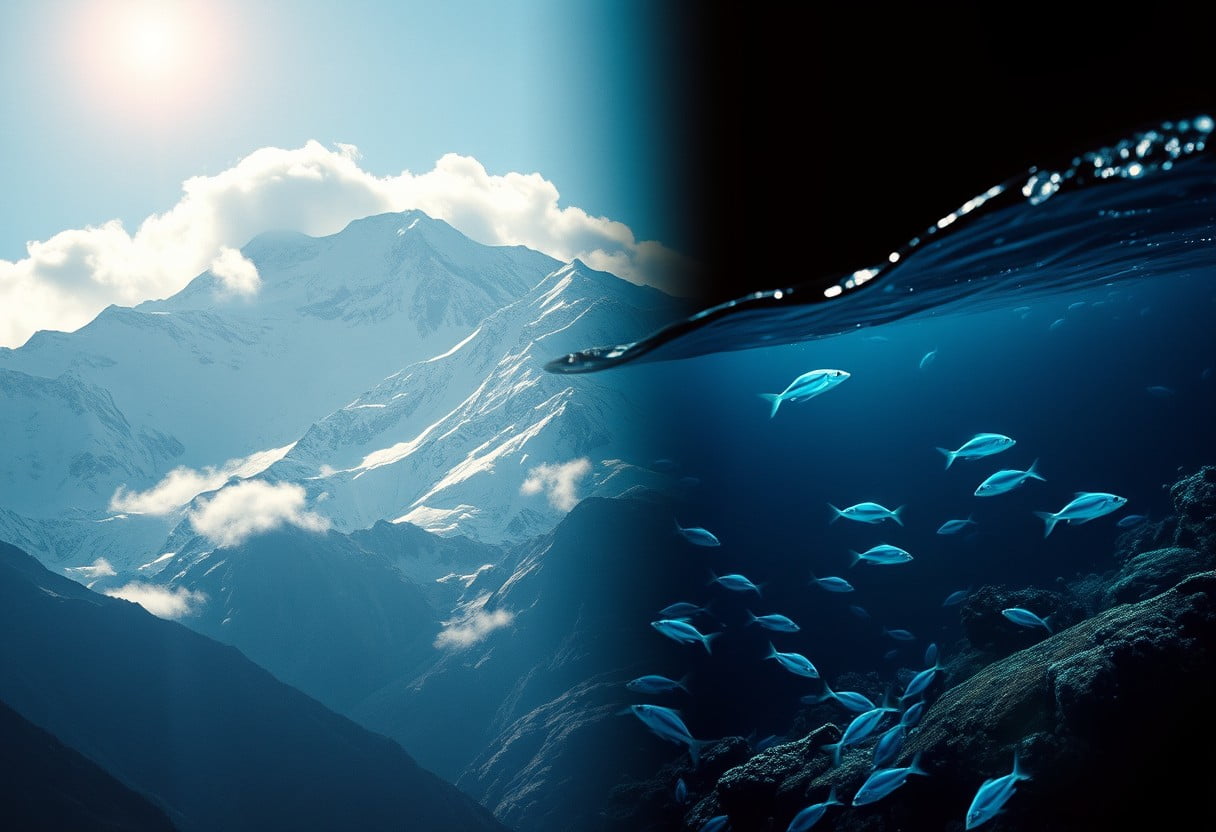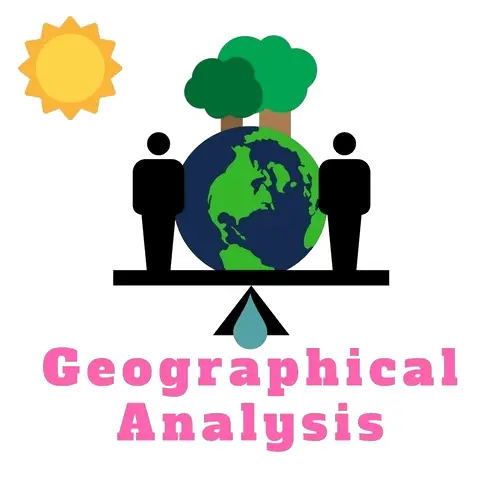Just as you marvel at the towering heights of the world’s major mountain ranges, you may also be intrigued by the vast depths of the oceans below. This blog post invites you to explore a comparative study of these two extreme environments, highlighting the towering peaks of the Himalayas and the deep trenches of the Pacific. By understanding the characteristics, formations, and significance of both mountains and ocean depths, you’ll gain a deeper appreciation for the remarkable dynamics of our planet’s topography and the profound natural forces at play.

Key Takeaways:
- Elevation vs. Depth: The study compares the highest points of major mountain ranges with the deepest ocean trenches, showcasing the extremes of Earth’s topography.
- Geological Processes: Insights into how tectonic activity influences both mountain formation and oceanic trench depths reveal the dynamic nature of Earth’s crust.
- Environmental Impact: Discussion on how climate, weather patterns, and biodiversity vary between these two extreme environments, highlighting their ecological significance.
- Human Exploration: The research emphasizes the challenges and advancements in exploring both the peaks of mountains and the depths of oceans, including technological innovations.
- Sustainability Concerns: An exploration of conservation issues related to both mountain regions and oceanic environments as human activity continues to impact these fragile ecosystems.

The Science of Elevation
While exploring the world’s natural wonders, it’s important for you to understand the fundamental concepts behind mountain ranges and how they are categorized. Mountains boast distinct characteristics that differentiate them from hills and plateaus; elevation being the primary metric. The classification of these elevated landscapes isn’t just based on their height, but also on factors like location, structure, and regional geology. You’ll often hear geological definitions that reference massifs, ranges, or chains, each term carrying specific implications about the spatial arrangement and composition of these formations.
Defining Mountain Ranges
Any mountain range can be thought of as a series of peaks and ridges that share a common origin, generally resulting from tectonic forces shifting the Earth’s crust. They stretch for miles and may contain numerous interconnected summits. You might recognize famous mountain ranges such as the Himalayas or the Rockies, each presenting a unique profile, ecosystem, and geological history. In your discussions about elevation, consider how these ranges possess their own identities shaped by both their biogeography and climatic conditions.
Geological Formation of Mountains
With a growing understanding of geology, you can appreciate that mountains do not simply rise sporadically from the earth’s surface; their formation is a complex interplay of tectonic activities. Mountain ranges are often formed at the boundaries of tectonic plates, where these gigantic slabs of the Earth’s crust collide, pull apart, or slide past each other. This process leads to the creation of monumental structures, which can take millions of years to form. For instance, when two continental plates converge, they can force material upward to create a mountain range, a phenomenon seen in places like the Andes. Understanding these processes arms you with the knowledge of how mountains continue to evolve and change over time.
Mountains can also arise through volcanic activity, where molten rock escapes to the surface, solidifying over time and creating geologically young mountains, such as those found in the Cascade Range. The factors influencing their elevation are intrinsic to the dynamic nature of our planet, making the study of mountains a fascinating journey through Earth’s crust.
Measuring Elevation: Techniques and Tools
Tools and techniques used to measure elevation have significantly evolved, showcasing humanity’s ingenuity. You may come across various methods ranging from traditional techniques like surveying with levels and theodolites to modern GPS technology which provides precise measurements in real-time. The advent of remote sensing also allows you to gather elevation data using satellites, making the process faster and more efficient. Each technique offers a different level of precision, allowing you to choose based on the requirements of your project or study.
In a world where geographic information is increasingly vital, understanding the nuances of measuring elevation can empower you to accurately assess and report on the majestic landscapes you encounter. With ongoing advancements in technology, your ability to measure, analyze, and appreciate the vast heights of mountains continues to grow.
Geological techniques also play a crucial role in determining elevation, particularly in understanding the movement of tectonic plates and their implications on topography. Ground-penetrating radar and LiDAR technology now enable scientists to visualize and measure changes in landforms with remarkable accuracy. This information not only sheds light on current elevations but also provides insight into historical geological events that shaped the mountains you see today.

The Majesty of Major Mountain Ranges
Some of the world’s most breathtaking natural landscapes are formed by major mountain ranges. These colossal structures not only provide stunning visuals but also contribute to the ecological diversity and climate of their respective regions. You may discover a comprehensive analysis on this topic in the article, A hierarchical inventory of the world’s mountains for global …. Among these monumental formations, a few stand out due to their unique characteristics and historical significance, revealing the intricate stories of our planet.
The Himalayas: A Natural Barrier
Barrier-like, the Himalayas form a formidable natural boundary that separates the Indian subcontinent from the Tibetan Plateau. Dominating the skyline, this mountain range boasts some of the highest peaks on Earth, including Mount Everest. The sheer magnitude of the Himalayas makes them a focal point for climatological shifts, influencing weather patterns and monsoon cycles across the region. As such, you can explore how they have shaped not just geological features but also the cultures and societies surrounding these awe-inspiring mountains.
In addition to being an ecological haven, the Himalayas serve as a crucial cultural and spiritual nexus. Numerous ancient civilizations have formed in its shadow, thriving on the natural resources provided by these mountains. You may find that the impact of the Himalayas on local communities extends beyond physical barriers, creating unique cultural identities that have persisted through the ages.
The Andes: A Continuous Geological Marvel
Geological transformations shape the Andes into a fascinating continuous chain of peaks stretching over 4,300 miles along the western edge of South America. This majestic range showcases a diverse array of ecosystems and climatic conditions, influenced by altitude and geographic variability. As you traverse the Andes, you’ll encounter rich biodiversity, vibrant cultures, and ancient histories interwoven into the landscapes that define this awe-inspiring formation.
With an age that dates back millions of years, the Andes continue to evolve due to ongoing tectonic activities. This results in unique geological features, such as volcanic formations and deep valleys, that offer remarkable opportunities for scientific study and exploration. You may find the history of the Andes has played a significant role in shaping South American culture, contributing to the identities of its indigenous peoples and modern-day communities.
The Rockies: Historical Significance
An iconic landmark, the Rocky Mountains stretch across North America, pulling you into the stories of pioneer trails and ancient indigenous pathways. These mountains served as vital routes for settlers and explorers, impacting the patterns of westward expansion throughout the United States and Canada. The Rockies encapsulate a wealth of history, offering you the chance to explore national parks that are famed for their pristine beauty and recreational opportunities.
Andes further illustrate the complex tapestry of U.S. history. The Gold Rush in the 19th century saw an influx of settlers and the establishment of towns, leading to the growth of industries that still shape the region today. If you’re keen on understanding more about the West’s historical context, the Rockies stand as a symbol of adventure and the human spirit in overcoming nature’s grandeur.
The Alps: A European Icon
On the other side of the Atlantic, the Alps represent not just a physical barrier but also a cultural one. Spanning across several countries, including France, Switzerland, and Italy, the Alps are a blend of breathtaking scenery, rich history, and vibrant local traditions. If you’re lucky enough to visit, you’ll encounter charming towns and breathtaking landscapes that captivate travelers and mountain enthusiasts alike.
A striking feature of the Alps is their influence on art and culture in Europe. Lush valleys and snow-capped peaks have inspired countless artists, writers, and musicians throughout history. As you investigate into the cultural significance of this mountain range, you’ll see how it shapes not only physical experiences but also fosters emotional connections that resonate across generations.
Understanding Ocean Depths
Now, let’s probe into the fascinating world of ocean depths, a realm that covers over 70% of the Earth’s surface and plays a crucial role in global ecosystems and climate regulation. It is important to comprehend the immense volume of water that fuels our oceans, which is densely packed with features ranging from the majestic abyssal plains to towering mid-ocean ridges. The ocean floor is not just a flat surface; it consists of various layers and structures, all unique in their formation and significance.
The Structure of the Ocean Floor
Depths beneath the waves reveal a complex structure that can be categorized into distinct zones, including the continental shelf, continental slope, abyssal plain, and oceanic ridges. Each of these regions serves a different function and hosts a myriad of marine life adapted to specific environmental conditions. The continental shelf tends to be shallow, rich in nutrients, making it a bustling hub for fishing and other marine activities. As you move further away from land, you will encounter the steeper continental slope, which typically leads down to the abyssal plain—the flat and deep areas of the ocean where sediments accumulate over time.
Moreover, the oceanic ridges, formed by tectonic activity, can be seen as the spinal column of the ocean floor, closely intertwined with volcanic activity and the spreading of tectonic plates. These features not only shape the physical landscape of the oceans but also influence various ecosystems and global ocean currents, making understanding them critical for your study of oceanography.
Measuring Depth: Techniques and Instruments
To accurately measure the depths of the ocean, various techniques and instruments are employed, each with its own unique methodology and application. Traditional soundings involved using lead lines, but modern methods rely heavily on sonar (Sound Navigation and Ranging) technology, which sends sound waves to the ocean floor and interprets the time it takes for the waves to return. This information allows you to create accurate mappings of the ocean floor, revealing a highly detailed topography of the seabed.
Measuring depth can also involve satellite altimetry, which provides data based on the fluctuations in sea surface height caused by underwater features. This technique is particularly useful for mapping large areas of the ocean swiftly and at a broader scale than traditional methods. The combination of these techniques enables you to gain nuanced insights into ocean depths, contributing invaluable data for climate research, ecological studies, and geological investigations.
Types of Oceanic Features: Trenches, Ridges, and Basins
Techniques used to explore oceanic features include sonar mapping and remotely operated vehicles (ROVs), which dive deep to collect visual and physical data. The significance of identifying trenches, ridges, and basins cannot be understated, as these geological formations impact ocean currents, habitats, and biodiversity. Trenches, for example, are some of the deepest parts of the ocean, formed by the subduction of tectonic plates, while ridges and basins create diverse marine environments. They serve as critical habitats for various marine species and can also be associated with mineral deposits important for human activity.
| Oceanic Feature | Description |
|---|---|
| Trenches | Deep, narrow depressions formed by tectonic plate subduction. |
| Ridges | Elevated areas like mid-ocean ridges created by tectonic activity. |
| Basins | Low areas of the ocean floor that collect sediments over time. |
| Abyssal Plains | Flat areas of the ocean floor, often covered in thick sediment. |
| Seamounts | Underwater mountains formed by volcanic activity. |
Any exploration of the ocean’s depths is not only scientific but also an adventure in understanding Earth’s geological history and its current ecological dynamics. Your insights into these oceanic features can greatly enhance your appreciation of how interconnected our planet’s systems are.
Structure of oceanic features also involves understanding their respective formations and how they relate to the overall functioning of marine ecosystems. You will find that different regions harbor distinct populations of marine flora and fauna, which have adapted to their immediate surroundings. This intricate web of life, including organisms that have yet to be discovered, contributes to a biodiverse ocean environment.
- Trenches host unique species adapted to extreme conditions.
- Ridges often serve as hotspots for biodiversity due to nutrient upwellings.
- Basins can reveal historical climate data through sediment cores.
- Abyssal plains are home to some of the least explored ecosystems.
- Seamounts act as aquatic mountains that provide habitats for various marine species.
Any thorough study of ocean features unveils the remarkable complexity of marine ecosystems and the vital roles they play on a global scale.

Major Ocean Depths Explored
To truly understand our planet’s structure, it’s crucial to explore the most profound aspects of the world’s oceans. Below the waves lie the oceanic trenches, some of which reach depths that challenge our comprehension. These locations not only host unique ecosystems but also have significant geological importance. In this chapter, you will journey through some of the deepest oceanic trenches, uncovering their remarkable characteristics and the mysteries that lie within their depths.
Mariana Trench: The Deepest Point on Earth
Point Nemo, known as the Mariana Trench, is the deepest point on Earth, plunging approximately 36,000 feet below the surface of the Pacific Ocean. This remarkable trench stretches for about 1,550 miles and is located to the east of the Mariana Islands. Its extreme depths make it a focal point for scientists and researchers seeking to understand not only oceanic phenomena but also the Earth’s geological processes. The trench is renowned for its unique environment, where pressure is immense, and temperatures hover around freezing, making it a home to organisms that thrive in the most challenging conditions.
This trench is a treasure trove of biodiversity and a natural laboratory for studying deep-sea life. Among its residents, you’ll find extremophiles, organisms that thrive under extreme pressure and little to no sunlight. These organisms provide insight into the limits of life on Earth and raise questions about life’s potential on other planets. Therefore, your exploration of the Mariana Trench not only enriches your understanding of our planet but also expands the boundaries of life’s possibilities beyond Earth.
Tonga Trench: Depths of the Pacific
Pacific to the east of the Fiji Islands lies the Tonga Trench, another significant topographical feature that ranks as the second-deepest oceanic trench. Reaching depths of about 35,000 feet, the Tonga Trench showcases the complex interactions of tectonic plates and subduction processes that shape our earth. This remarkable location is not only a geological marvel but also a vital area for marine research, as it has been the focus of numerous oceanographic studies exploring the unique life forms and ecosystems that exist in such extreme environments.
Another interesting aspect of the Tonga Trench is its status as a geological hotspot, where tectonic activity is prevalent. This area is often characterized by volcanic activities, contributing to the creation of new landforms and altering the existing ones. As you probe deeper into its depths, you may discover new species adapted to survive in these harsh conditions, enhancing your appreciation for the resilience of life in extreme environments.
Puerto Rico Trench: Caribbean Secrets
Pointing to the north of the Caribbean Sea, the Puerto Rico Trench is the deepest part of the Atlantic Ocean and plays a critical role in the geological framework of the region. Reaching depths of about 28,000 feet, this trench is not only important for its depth but also for its role in the tectonic interactions between the North American and Caribbean Plates. This particular area is renowned for its geological activity, which can lead to seismic events, making it a subject of extensive research in both geology and seismology.
Depths of the Puerto Rico Trench are still somewhat of a mystery, with scientists continually uncovering new secrets about its formation and the life forms that call it home. Various studies have indicated the presence of unique biological communities that have adapted to the extreme pressures and conditions of the trench, offering valuable insight into evolutionary processes. By exploring these depths, you can gain a better understanding of the dynamic systems that govern the Earth’s oceans and their profound impacts on climate and sea life.
Java Trench: An Indian Ocean Mystery
Caribbean mysteries unfold within the Java Trench, located to the south of Indonesia. Also known as the Sunda Trench, this underwater canyon plunges to about 24,000 feet, making it one of the deepest points in the Indian Ocean. The trench plays a significant role in the tectonic activities of the region, particularly in its interaction with the Australian and Eurasian tectonic plates. As you explore the Java Trench, you will uncover its impact on local geological events, including earthquakes and volcanic eruptions that can reshape coastal landscapes.
Major scientific research endeavors in the Java Trench focus on understanding its ecological importance as well. The trench harbors a plethora of marine life that has adapted to the high-pressure conditions and complete darkness. Insights gained from the Java Trench can aid in understanding ocean chemistry and ecosystems, contributing significantly to global biological research. Your journey through this trench deepens your connection with the ocean while fostering a greater appreciation for the intricate balance of life it sustains, even in the most daunting of environments.
Comparative Analysis of Peaks and Depths
Unlike the vast expanses of the ocean’s depths, mountain ranges represent the heights of terrestrial landscapes, creating a fascinating juxtaposition of nature’s extremes. To appreciate the stunning variety of conditions and environments, it’s important to understand the distinctions and similarities between these two remarkable features. Below, you will find a comparative analysis that highlights the key elements of both peaks and depths:
| Aspect | Mountain Ranges (Peaks) | Ocean Depths |
|---|---|---|
| Average Height/Depth | Ranges from about 1,000 meters to over 8,848 meters (Mount Everest) | Ranges from about 0 meters to over 11,000 meters (Mariana Trench) |
| Accessibility | Often accessible for trekking and climbing, though altitude can pose challenges | Deep sea exploration is largely limited to specialized technologies |
| Biodiversity | Home to a wide variety of flora and fauna adapted to high altitudes | Home to unique species adapted to extreme pressure and darkness |
| Climate | Typically colder with variable weather; affected by altitude | Generally stable temperatures but influenced by deep-sea currents |
| Human Impact | Tourism, mining, and climate change are pressing concerns | Pollution from surface activities can impact deep-sea ecosystems |
Height vs. Depth: A Geographical Perspective
Peaks and depths represent the extremes of our planet’s topography. Mountains tower above sea level, creating dramatic skylines and serving as natural barriers that influence local climates and ecosystems. When you think about the world’s highest mountains, envision the incredible forces of tectonics that push such heights into the sky. The measurement of height of a mountain is not only about its physical altitude but also a testament to geological history and activity.
On the other hand, ocean depths plunge into an entirely different world. While you may think of depth as simply the absence of land, it represents a complex environment teeming with unique phenomena. Submarine topography, including canyons, ridges, and trenches, creates diverse habitats that hold multitude of life forms that thrive in the darkness of the ocean depths. Therefore, the geographical perspective emphasizes that both peaks and depths embody important, albeit contrasting, aspects of Earth’s crust.
Biodiversity in Extreme Environments
To fully appreciate the ecosystems present in both mountain ranges and ocean depths, one must examine the unique biodiversity that exists in these extreme environments. Peaks host species that have adapted to high altitudes, where oxygen levels are low, and temperatures plummet. Plants like the edelweiss have evolved to withstand harsh winds and cold, while mountain goats showcase remarkable agility on steep slopes. In contrast, the ocean depths harbor organisms that thrive in complete darkness and under immense pressure. Creatures like the anglerfish and giant squid have adapted extraordinary means to hunt and survive in their nutrient-sparse environments.
Analysis of these ecosystems highlights the resilience of life. Both mountain ranges and deep-sea environments are subject to ecological niches that force species to adapt in remarkable ways. You’ll find that, while the challenges they face are vastly different, the innovative strategies they develop reveal the powerful theme of evolution in extreme conditions.
Climate Impact on High Altitude and Deep Sea
Altitude plays a significant role in influencing climate conditions at high elevations. The higher you ascend a mountain, the lower the temperature tends to drop, with each increase in altitude resulting in a progressive decrease in atmospheric pressure. This climatic shift results in unique weather patterns, often characterized by sudden changes that can be perilous for climbers and travelers. Understanding these conditions is crucial for anyone seeking to explore high-altitude environments.
Conversely, deep-sea ecosystems are characterized by stable temperatures and minimal light, but they are not immune to climate-induced changes. As surface temperatures rise due to global warming, these changes influence currents and nutrient flows, which can drastically alter the delicate balance of life in the ocean’s depths. From both an ecological and research perspective, recognizing these climatic impacts is important for protecting and preserving biodiversity in these extreme realms.
Understanding the relationship between climate and these extreme environments further emphasizes the call for awareness and conservation efforts. By keeping abreast of these shifts, you can actively participate in the global mission to protect both mountain ranges and ocean depths from the detrimental effects of climate change.
Human Interaction with Peaks and Depths
All around the world, the majestic peaks of mountain ranges and the profound depths of oceans have captured human imagination and shaped cultures for centuries. These landscapes, both grand and intimidating, have influenced communities’ beliefs, folklore, and practices, imbuing them with cultural significance. From sacred mountains revered in ancient traditions to the mythologies tied to the mysterious oceans, your understanding of these natural wonders will provide insight into how they resonate deeply with your own culture and identity.
Cultural Significance of Mountain Ranges
With every ascent of a mountain, you may find a myriad of cultural practices that celebrate these impressive formations. For many Indigenous and local communities, mountains are perceived as sacred spaces, embodying spiritual significance or serving as the setting for traditional ceremonies. The towering peaks are often associated with deities or ancestors, acting as a bridge between the earthly and the divine. Embracing the natural beauty around you, you may find that climbing mountains has become a rite of passage or personal reflection for individuals seeking a deeper connection to their heritage.
Exploration and Research in Ocean Depths
Ocean exploration has pushed the limits of human understanding, revealing the mysteries that lie beneath your waters. Adventurers and researchers alike have long been captivated by the diverse ecosystems found in ocean depths. You might appreciate how technological advancements have transformed underwater exploration, enabling scientists to study oceanic phenomena and marine life. From deep-sea submersibles to remotely operated vehicles, these innovations allow you to unveil the secrets of the planet’s vast bodies of water, which play a critical role in sustaining life on Earth.
Another crucial aspect of exploring ocean depths is the ongoing research on environmental impacts. As you explore into the complexities of marine biology and ecosystems, consider how human activities like fishing, pollution, and climate change have jeopardized ocean health. Researchers work tirelessly to collect data on these pressing issues, ensuring that you are informed about the threats facing your oceans and the importance of sustainable practices in preserving these vital resources.
Conservation Challenges: Mountains and Oceans
On the frontlines of environmental preservation, the challenges faced by both mountains and oceans are remarkably similar. You may be aware that climate change is causing glacial retreat in mountain ranges, affecting water supply to numerous regions, while also threatening the delicate balance of ocean ecosystems. Moreover, tourism and human encroachment place additional strain on these natural habitats, requiring your attention and commitment to conservation initiatives that protect these breathtaking landscapes for future generations.
Ranges across the globe are witnessing shifts in biodiversity due to habitat loss and pollution, raising urgent concerns for their conservation. As someone who cherishes nature, you should consider how your choices impact these vital ecosystems. Whether it’s advocating for protective legislation or participating in local clean-up efforts, your actions can contribute to a collective movement aimed at restoring and maintaining the majesty of our peaks and depths.
Summing up
Drawing together the remarkable contrasts between the world’s major mountain ranges and ocean depths not only enhances your understanding of our planet’s geography but also emphasizes the dynamic processes that shape it. As you’ve explored, peaks such as the Himalayas and the Andes soar to breathtaking heights, embodying the force of tectonic activity and the Earth’s crustal resilience. Conversely, the ocean depths, exemplified by the Mariana Trench, reveal the profound mysteries of the ocean floor, emerging from the same geological forces but manifesting in a drastically different manner. This comparative study provides you not only with insight into physical geography but also instills a sense of the Earth’s vastness and interconnectedness.
Moreover, recognizing the interdependence of these extreme environments fosters an appreciation for the delicate balance within our ecosystem. The ecosystems thriving at these altitudes and depths highlight the adaptability of life, encouraging you to consider the effects of climate change and human intervention on these unique habitats. By understanding the significance of both mountains and ocean depths, you equip yourself with a broader perspective on environmental stewardship and the importance of preserving the planet’s diverse landscapes. This knowledge empowers you to engage more thoughtfully with issues pertaining to environmental conservation and climate resilience in your daily life.









